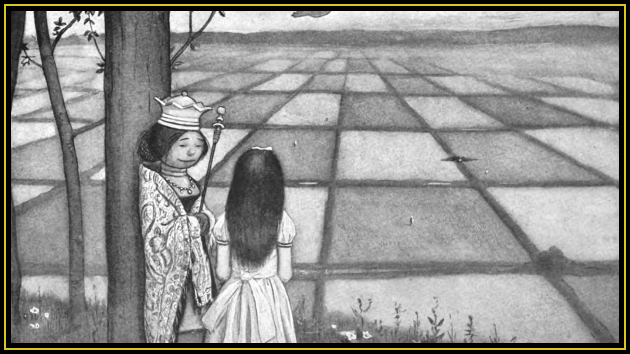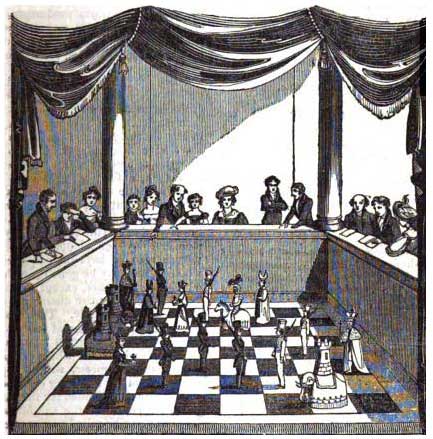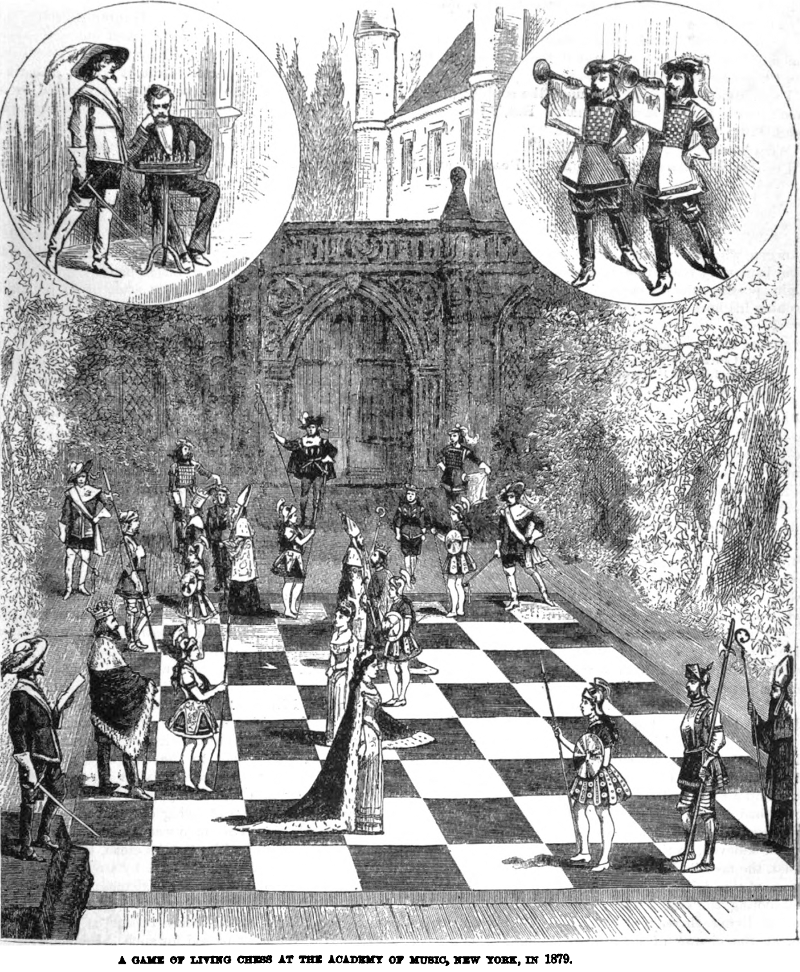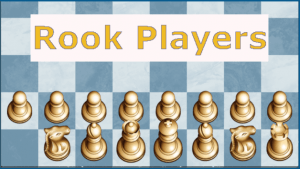
Living Chess - The Golden Age
 [cover image from Through the Looking-Glass and What Alice Found There
[cover image from Through the Looking-Glass and What Alice Found There
by Lewis Carroll; illustrated by Peter Newell, 1902 ]
________________________________________________________________________________________________________
This promises to be a rather long and disjointed presentation as it bounces from one thing to another just as they presented themselves to me.
Years ago I had created several blog articles on Living Chess but since the images were linked to my chess.com photo albums which disappeared with the solidification of v3, they are rather unappealing at this time. The point is that, as I'm not a stranger to Living Chess. It catches my eye when I happen across any mention of the subject.
Weeks ago, I was reading a blog by @simaginfan about Elijah Williams, in which he mentioned Charles Tomlinson's article, "Chess Resorts" (BCM Feb. 1891, pp. 46-54). Going back to re-read the Tomlinson's entire article in the original, I stumbled over this lovely poem on p. 44:

This poem piqued my curiosity. I've never been to England but I know that St. Leonards-on-Sea is located near Hastings (there's a Hastings & St. Leonards Chess Club, founded in 1882, still in operation) so my assumption was that would be the St. Leonard's from the poem. Also assuming that an event worthy of being memorialized in verse would be highly publicized, I expected to find a full description on the pages of the British Chess Magazine. But I only found silence. As much as I relish peace and quiet in my life, I can't abide it from places meant to speak to me. . . and so began my merry, meandering mission of mining for words.
Even if English chess periodicals didn't want to discuss Living Chess as St. Leonards, other places did. One was the London Morning Post, January 14, 1891 who told what would happen:
The players of the games at the forthcoming living chess tournament at St. Leonards-on-Sea, in aid of the Men's Help Society, will be the Hon. Reginald Capell and Mr. W.Shadforth Boger, the latter taking the place of Mr. A. M. Brookfield, M.P., who is prevented by a family bereavement from taking part in the contest. Yesterday afternoon a successful dress rehearsal took place at the Royal Concert HalL
The personators on the red side were Lord and Lady Brassey as King and Queen ; the Hon. Muriel and Hon. Marie Brassey, Rooks ; Miss Hilda Brassey and Lady Beatrice Capell, Bishops ; and Hon. T. A. Brassey and Mr. Harvey Combe as Knights; while the Misses Gwendoline, Violet, Beatrice, and Iris Brassey, Masters Bamsey Murray, Walter Scholfield, and Robert Raper, and Mr. Edgar Brassey figured at Pawns.
Vis-a-vis with these were Captain Gaskell and Miss Forbes, as the White King and Queen ; Miss Mildred Hayley and Mrs. Lambert as Rooks ; Miss Fapillon and Mrs. Ebden as Bishops; Mr. C. Thursby and Baron von Roemer as Knights ; and Master Robin Follett, Miss Ada Murray, Master Willie Hayley, Miss Winifred Dyke, Master Edward Brookfield, Miss Maud Scholfield, Master Thomas, and Miss Gladys Ebden constituted the Pawns.
The display will commence and end with grand processions of the pieces, while appropriate incidental music is provided by the Hastings and St. Leonards Ladies' Orchestra. The costumes, of the Tudor period, have been admirably designed, and are most elaborate, being chiefly of red satin, slashed and puffed with cloth of gold, the white dresses being in satin and silver. The first performance takes place tonight, and the second to-morrow afternoon, at three o'clock Royal Colonial Institute.
The Nuova rivista degli scacchi continues with what did happen in some detail:
The action began, as is customary on such occasions, with a procession of the "Pieces," pompously adorned, made at the sound of a march, before they occupied their respective squares. The picturesque clothes were such as they were worn at the time of Tudor (royal family of England); the White troops were dressed in white satin mixed with silver and the Red (Black) troops in red satin embroidered in gold and with gold flakes. The two games were conducted by Mr Reginald Capell and by Mr W. Shadforth Boger. The first game, a brilliant Kieseritzky Gambit, was won by White, and the second, a Defense Philidor, was won by Black.
After lunch on the first day, Messrs. Hirschfeld and Hoffer played two brilliant games, and in the evening the players were Rev. G. A. Mac Donnell and Dr. Ballard. On the second day Gunsberg and the Hofferr played three games. Englisch and Tschigorin played in the evening, and on the third day doctors Noa and Zukertort, and Englisch and Rosenthal played several games.
So my quest was completed —but, as with most quests, I stumbled upon troves of fascinating treasures along the way, some new, some just forgotten.

Living Chess - using humans for chess pieces - has been a matter of legend for a long time. I've seen it written (in "A History of Chess" by Jerzy Gizycki, and Baruch H. Wood in 1972) , though I haven't been able to corroborate, that Charles Martel, introduced Living Chess to Europe in the 8th century.
There are also tales of rulers using people, enemies/captives, Caligula-like, as pieces, killing those who get captured on the board. An article from "Frank Leslie's Popular Monthly" (1883) called "Living Chess" claims that the Mughal, India emperor, Akbar (1542-1605) supposedly played a game of living chess on the pavement of the Pachisi court at Fatehpur Sikri using slave girls as the pieces. One version of this tale can be found in "Travels in India and Kashmir" By Erich Schönberg 1853:
It was here that Ackbar and his two viziers, Abul Fazel and Byrber, played at chess. Instead of castles and bishops, knights and pawns, the royal Moslem had arrayed upon his chess-board living maidens. These were divided into groups, distinguished by the colour of the dress. Four wore black, four red, four yellow, and four appeared in white. Living chess-maidens was an invention worthy of an emperor. And their tiny feet, stepping from square to square of the royal chess-board, spared the luxurious Asiatic the trouble of extending his imperial hand. Whoever could “check” the king, carried off a large booty, for these living castles, pawns, and knights, became the spoil of the victor.
But all these stories come from third-hand sources. Factual instances of Living Chess in olden times are rare. The earliest known written depiction of Living Chess of which I'm aware is in the 1499 allegory (probably written circa 1467), Hypnerotomachia Poliphili (translated into English in 1592 as The Strife of Love in a Dream or The Dream of Poliphilus) by Francesco Colonna (1434-1527) a Dominican monk. In this rather sensual story, Poliphilus falls asleep, pining for Polia, bemoaning his unrequited love for her. During his dream he is invited to a luxurious feast at the court of of Queen Eleuterylida during which a chess ballet entertains them. In The Strife of Love in a Dream, edited by Andrew Lang in 1890, the chess ballet is described in great detail in pages 144-148. It begins:
"By the entraunce of the curtaine there came in thirty two Nymphes, whereof sixteene were apparrelled in cloth of Gold (eyght uniformally without difference of degrees) afterwards one of those sixteene was aparrelled in princely robes lyke a King, and the other lyke a Queene, with two tower-keepers or Rookes, as wee tearme them, two counsellkeepers or Secretaries, we tearme them Bishoppes, and two Knights. In like sort were eight other in cloth of silver, under the like governement and magistracie as aforesaid."
The 5th book (ch. 24-25) of François Rabelais' Heroic Deeds and Sayings of Gargantua and His Son Pantagruel, posthumously published in 1564, relied heavily on Colonna's story with it's own chess ballet. Its descriptions, rich and inspired, begin:
After supper there was a ball in the form of a tilt or a tournament, not only worth seeing, but also never to be forgotten. First, the floor of the hall was covered with a large piece of velveted white and yellow chequered tapestry, each chequer exactly square, and three full spans in breadth.
Then thirty-two young persons came into the hall; sixteen of them arrayed in cloth of gold, and of these eight were young nymphs such as the ancients described Diana’s attendants; the other eight were a king, a queen, two wardens of the castle, two knights, and two archers. Those of the other band were clad in cloth of silver.
One can read (and I highly recommend it) a translation of Book V, chapter 24, How there was a ball in the manner of a tournament, at which Queen Whims was present, which explains the game of chess : Here
One can read a translation of Book V, chapter 25, How the thirty-two persons at the ball fought, which describes the game played in the story: Here
Thomas Middleton's clever 1624 book, A Game of Chess, took a different twist by making the characters in his satirical work chess pieces and the play itself a game of (political/religious) chess. It was living chess served up in an original fashion.
HJR Murray claimed that the 1551 work of Innocenzio Rhingieri, Cento giuochi liberali, et d'ingegno, offers a game of living chess (il Giuoco de Scacchi umani). I was able to find words within the book referring to such a game, but couldn't interpret the text well enough to understand it.
In 1527 Marco Girolamo Vida wrote Scacchia Ludus, a latin poem in which boxwoods transform into living chess pieces:
We play an effigy of war and imitation battles
Real armies made from boxwood upon play kingdoms,
As twin kings, white and black opposing each other,
Fight for glory with bicolored armies.
(my own liberal translation from the original Latin)

All these fanciful games appeared in literature in or before the 16th century. Then all interest in living chess came to a halt. With just one exception (Twiss, 1787), it's almost the mid 19th century before there are any more references to Living Chess. Even the one reference above to Akbar was in 1833. Napoleon Marache notes in his The Chess Palladium and Mathematical Sphinx Oct. 1846 another legend (this story is mentioned by Richard Twiss in his seminal 1787 work, "Chess," Pt.1, p.26, who in turn cites Dr. Thomas Hyde as his own source):
Don John, of Austria, possessed a magnificent chamber, floored with a wide, square, chequered pavement of black and white marble, upon which, for the frequent entertainment of his court, he had grand exhibition games of living Chess played, conducted by the distinguished players of his kingdom. Himself took the part of King, opposed to some noble Duke, while Queens, Knights, Bishops, Ministers, and Guards, (or rocks and pawns.) each of appropriate stature and costume, completed the ranks in order, and under the direction of two opposing champions, the respective parties moved upon the squares according to the laws of Chess. The victorious side awarded honors and gifts to the cavalier who procured checkmate.
But the first actual recorded instance of living chess I was able to uncover occur was in an obscure magazine, New Monthly Belle Assemblée (a London-based magazine of "literature and fashion") in June 1836:

Notes and Queries, April 25, 1857 refers back to this exhibition in the Lowther Rooms while informing us of a couple more recent examples:
A NOVEL GAME OF CHESS. –Mr. Hackwood having sent an extract from Le Nord, may not be aware that the novel game of chess to which he alludes has already been practised in this country. Some fifteen or sixteen years since, on the opening of the Lowther Rooms, in King William Street, Strand, since the temporary Chapel of the Oratorians, and still more recently occupied as Mr. Woodin’s Polygraphic Hall, there is a large chess-board laid on the floor, and men and women, dressed as pawns and pieces, were in attendauce for the use of those who might choose to play at what was termed a “living chess.” The manner was as follows:—The players were mounted in two boxes, something like pulpits, and directed the living chess to move, or take an opponent, which was always conducted by an encounter of weapons, and the defeated person driven off the board. The charge was five shillings each player per game, and the public were admitted at one shilling each as spectators. This account may be relied on, as the writer, being a lover of the game, once ventured to play a game with the “living chess;” but he found that however novel the affair was, though it might do for once, yet the battling of men and their not being specimens of “still life,” was very perplexing to the player, and from the fidgetting of the individual chess-men he was in momentary expectation of seeing some of his pawns, or pieces, take huff and walk off the board without leave. The speculation was not a successful one, as few good players adopted a second edition of the game; so it remained open but two or three months, and the kings, queens, bishops, knights, rooks, and pawns, doffed their costume, and sought employment in some other sphere where they were more at liberty to follow their own inclination than at a “living chess.”
Although the 1836 exhibition seems to be the first documented instance of Living Chess, shortly before that, in 1831, a correspondent to Mechanic's Magazine suggested (with illustrations) a possible method for staging such an event while hinting that other methods have been used before -
We have here living men in lieu of images, and an image in the place of a living player. It is now my intention to proceed with a brief account of a scheme for playing this noble and scientific game with an animated dramatis persons, but in a manner much similar to a pantomime, and suitable for public exhibition. It differs from any other plan that has been adopted, in this, that though men or boys be employed, the whole game may be gone through without breaking silence, except to proclaim "check," or otherwise distracting the attention of an assembly. That it is possible to place persons dressed in appropriate costume on a chequered plain, and inform them when and where to move by a mechanical process, will, I hope, be evident from the following description of the machinery intended for this purpose.
He goes on to describe his mechanical method (show below) in detail.




 "La Magicienne," a grand opera by Fromental Halévy which premiered on March 17, 1858 featured a ballet of living chess pieces in the 2nd act in which to captured pieces disappeared through a trap door in the stage. [image from Wikipedia]
"La Magicienne," a grand opera by Fromental Halévy which premiered on March 17, 1858 featured a ballet of living chess pieces in the 2nd act in which to captured pieces disappeared through a trap door in the stage. [image from Wikipedia]
I found another extensive living chess report in The Sussex Chess Magazine, May 1883:
The above clipping mention's "Hengler's Circus." Hengler's Grand Cirque was located on the site which now is the London Palladium. I found the 1883 exhibition mentioned above. It was advertised as "The Grand Military Tournament with Living Pieces" and ran on May 7, 8 and 9. It was a charitable venture for "The Royal Hospital for Children and Women, Waterloo Bridge Road, S.E., and the West End Hospital for Diseases of the Nervous system, 73, Welbeck Street, London."
 from the London Graphic, May 19, 1883
from the London Graphic, May 19, 1883
An elaborate affair, it was attended by "The Prince and Princess of Wales, accompanied by the Princes Albert Victor and George and the three young Princesses of Wales, the Duke and Duchess of Edinburgh, and the Princess Mary of Teck and suite."
"Messrs. Hirschfeld and Hoffer conducted two lively games, each winning one. At eight o’clock the Rev. Mr. MacDonnell and Dr. Ballard, jun., conducted two games, with the same result. The following day, during the morning performance, Messrs. Gunsberg and Hoffer played three games, winning one each and a draw, and in the evening Herren Englisch and Tchigorin were the performers, dividing honours. On the third day the morning performance was conducted by Drs. Noa and Zukertort, and on the third and last evening Herr Englisch and Mons. Rosenthal were the players."
The Coldstream Guards played the National Anthem. Onto a black and white chequered tarpaulin covering the floor, the chessmen, comprised of commissioned and non-commissioned officers as well as 'men and boys of the 'Household Brigade,' arrived in a procession:
"They were headed by the Chamberlain and preceded by the juvenile pipers of the Royal Caledonian Asylum. The procession was arranged in sections of two pieces and two pawns, a short halt between each section being permitted to give the first section time to occupy their squares, when the Chamberlain returned to usher in with military precision and in quick step the other section, and so on until the 'board' was complete."
Just as a side-note, "the costumes have been specially prepared by Messrs. Harrison Bros., Bow Street … Richard G. Kestin, P. F. Proctor, secretaries."
Steinitz had been suggested as a potential participant in the Grand Military Chess exhibition but that apparently never panned out. However, oddly enough, Steinitz, who had to have been aware of the 1883 event, wrote in the International Chess Magazine, June 1891:
—Two performances of Chess with living pieces recently took place at Hengler's Circus in London under royal patronage in aid of the Women's Help Society. English journals describe the affair as a grand success. But as usual hitherto in such performances the play was a mere sort of recitation, for the moves were called out by players who are hardly known in Chess circles from the printed record of selected old games, and the London Evening Post rightly suggests the improvement of introducing some real play between great masters on such occasions.
It seems the 1891 event used famous games - but the 1883 event were true contests. It also seems that Steinitz should have known this.

So, it's time for a brief respite and a look at where we are.
We started seeing occasional "novel" chess play in the form of living chess in England around mid century. But the 1880s ushered in a sort of Golden Era for Living Chess. From what I've looked at, it's quite likely that living chess displays are more common today but they seem to have lost most their glitter. Radio, TV, the internet, fast travel and more disposable time and income probably all harmonize to drown out the exotic feel the people from a century and a half ago must have experienced. With this in mind, let's continue on our non-chronological path to the Land of Living Pieces.

This above etching from The Illustrated London News depicts a living chess game from Thursday, Sept. 7, 1882. Starting at 4:40 pm, the game was played at Redworth Park, Heighington, England. The purpose of this event was to provide wholesome entertainment while raising funds for church bells. It was the idea of Rev. C. C. Chevallier, Vicar of Heighington. The pictured tent provided a shaded area for the refreshments. One report claimed "This novel Chess game is quite new in this country, the only approach to it being a game played by living players some years since in a Durham drawing-room."
Costumed parishioners were the chess men. One side wore green, the other red. The theme was the 15th century. The Pawns were pages wearing with long-pointed shoes and tights. The Bishops were dressed appropriately in mitered hats, carrying crosiers. Knights wore helmets and carried lances. The Rooks resembled castles while the Kings and Queens were appropriately attired. Rev. Chevallier opposed Mr. Johnson, of the Heighington School. The music was provided by New Shildon Temperance Band.
The advertisement below came from the 1886 Theatre Annual. That Harrison Brothers Costumiers advertise living chess costumes along with other theatrical accoutrements suggests the growing popularity of that chess genre.


Living Chess at the N.Y. Academy of Music
April 16, 1879



This sketch represents the "Tableaux d'Echecs Vivants"
at the Academy of Music, Manhattan, April 16, 1879
Going into the 1880s even in the United States living chess was becoming a sporadic form of entertainment. While the exhibition at the Academy of Music -an opera house/events venue, not a school- pictured above far outdistanced the English events in grandeur, pageantry and complexity, the profits collected by the Manhattan Chess Club weren't donated to any charitable cause but earmarked as prize money for some unspecified future international tournament (a 4,000 seat capacity, charging $1 for balcony seats and $.50 for general admission). The Academy of Music in Manhattan amazingly donated the use of the large 100'x40' hall for an entire month. The 32' square floor was covered with blue and white Canton twilled cotton cloth with a wide red border.
According to Charles Dickens Jr.'s All the Year Round, Oct. 28, 1882:
The kings [Mr. Faustsel, red; Mr. Leon Black, blue] wore the costume of Charlemagne, their jewel-decked robes differing but in color, one donning red, the other blue; their crowns being in one case gold, in the other, silver— or what passed for such. Rich dresses "of the historical period" draped the forms of the rivalled queens [Rachael Barrett, red queen; Miss Miller, blue queen], and “jeweled coronets sat upon their graceful heads.” The bishops wore highly decorated vestments, bore mitres, and carried croziers. The knights, wielding heavy pikes, were clad in bright armor. The rooks were distinguished by bearing miniature castles on their heads; and the pawns were represented by pretty girls of uniform height, in amazonian dress, and armed with spears and shields.
The Chess Player's Chronicle, June 1879, informs us:
...and when the curtain rose there was displayed a tableau vivant of Mephistopheles, in the person of Mr. Eitner [Hugo Eitner of the New York Chess Club], playing a game of Chess for the soul of the Prince (Mr. Jenkins). Behind them, on a raised platform, were Caissa, the Goddess of Chess, together with Clio and Enterpe, the Muses of History and Mnsic, all appropriately costumed.
The program consisted of several parts. First, trumpets announced the beginning of the activities. Mr. Fellows [Col. John R. Fellows who would be president of the 5th American chess Congress the following year] gave a speech and an introduction of the opposing players, Messrs. Mackenzie and Delmar who took their places and the following game ensued:
"Captain Mackenzie first called: “Pawn to king’s fourth.” A dainty miss of sixteen, whose long black hair hung loose over her helmet, was led to her square, and when Mr. Delmar‘s crier also made the same move, the two misses, standing face to face, suspended hostilities for the nonce, and exchanged smiles. The following move brought the captain’s knight to the king’s bishop’s third square, and Delmar made a similar move with his knight to his queen's bishop's square. Delmar’s fourth move was the capture of a red pawn by a bishop. Her rosy cheeks assumed a scarlet hue of mortification at being captured at such an early stage of the game, and as the pursuivant led her off, she pouted petulantly. The pouting was repeated on the sixth move, when Delmar, who seemed to take a great fancy to the pretty pawns, pitted a blue-eyed pawn against a red, and she, too, had to retire. The next move was another match of maiden against miss, and the queen’s bishop’s pawn of the gallant captain was the third victim. Mackenzie’s tenth move, after fine strategic manoeuvres, was a capture of a blue pawn, and three moves later his bishop vanquished a stately knight. The panoplied descendant of Henry the Second, twirling his moustache, sought consolation among the charming prisoners behind the wings. On the twenty-fifth move Delmar made a brilliant sacrifice of his bishop, which proved unfortunate, the captain's thirtieth move giving him checkmate." —All the Year Round.
After the game finished the curtain fell but soon rose again to reveal a living problem composed by E. B. Cook entitled Atlanta, the Fleet Footed Queen. After yet another curtain closure, the audience witnessed another game, this one a live reenactment of Morphy's blindfold game against Henri Baucher (one of eight played in Paris in 1858). Music during the performances and intermissions was provided by the Marine Band.
As one will see later on in this presentation, the Academy of Music Exhibition appears to have been a catalyst of sorts, encouraging others in the United States to follow its lead.

 The Royal Middy, Act II
The Royal Middy, Act II
The Band of Hope Union was a UK temperance organization formed in 1847 whose primarily focus was on educating children on the evils of alcohol and tobacco. With 2 million members in the British Isles and Australia, it had numerous affiliated chapters. To encourage children to join they offered outings, teas, music lessons and musical programs. These things cost money and from reading one of their newsletters, The Band of Hope Review and Childrens' Friend and from their guide on establishing chapters, one can read of their disdain of debt, which would be like "a nightmare, and produce stagnation and death."
Dublin's chapter was called the Hibernian Band of Hope -- and they were in debt.
The organizers planned a fundraising bazaar for February, 1891 hoping to relieve their debt. Luckily for them, Anna Cosgrave came up with the suggestion of staging a living chess show. Her husband, Dr. Ephraim MacDowel Cosgrave of the city Chess Club and Thomas Rowland (who married the famous problemist, Frideswide Fanny Beechey) of the Clontarf Chess Club located in Dublin's north side were selected to direct the pieces.
[Anyone interested in the multifarious Ephraim Cosgrave should read this]

After their initial success, these community minded chess enthusiasts formed a club called The Dublin Club of Living Chess. Or as Cosgrave himself wrote:
The first performances of the Club were given in the large Concert Hall of the Royal University, in support of the " Floral Fete," held on the 31st March and 1st April, 1891, with the object of raising an endowment for Botanical and Horticultural Scholarships, at the Alexandra College. Three performances were given. The vast hall, beautiful with floral decorations, was each time crowded. The players were W. H. S. Monck v. Mir Aulad AH, T. B. Rowland v. Dr. Cosgrave, and J. B. Pirn v. A. E. R. Joynt. The Countess of Zetland was present at one of the performances, and several hundred visitors had to be turned away owing to there not being room in the hall. The game played on this occasion was a Four Knights, between Dr. Cosgrave and T. B. Rowland.
The next performances of the Club were two given in the Antient Concert Rooms, on behalf of Jervis St. Hospital The players were the Lord Mayor of Dublin v. W. H. S. Monck, T. B. Rowland v. Lt.-Col. W. Lynam, and Dr. Cosgrave v. T. B. Rowland. On this occasion problems were for the first time set up, the audience being allowed a definite time to solve them. In one game the Kings were the players and directed the moves from the board.
The last performances of the season were given by the Club on May 10th, 1891, in the Ulster Hall, Belfast, on behalf of S. Luke's Church. The Club played both in the afternoon and evening to large audiences. Problems were again set, but this time diagrams of them were previously published, with an announcement that the first to send in a solution would be allowed to publicly solve the problem. All the problems were solved, and the solvers had the distinction of making the moves with the " Living Pieces." The players on this occasion were H. Seaver, C.E., v. T. B. Rowland, A. E. R. Joynt v. T. B. Rowland, D. E. Lowry v. A. E. R. . Joynt, W. Campbell v. Dr. Cosgrave.
 an ad for a Living Chess Club performance
an ad for a Living Chess Club performanceBelow are various games played by the members of the Dublin Club of Living Chess.
The article containing the next 5 games may be seen HERE
Another Living Chess production worth mentioning took place in Praque in 1895:

It would seem that during it's golden age, the last quarter of the 19th century, that Living Chess was played predominately in the UK. While most examples do seem to come from the UK, the United States also had caught the living chess fever.
This game was played in Sewickley, Pennsylvania in 1879:
The entire article can be read HERE.
This game was played in Atlanta, Georgia in 1883:
The entire article can be read HERE.
This game was played in Scranton, Pennsylvania in 1887:
The entire article can be read HERE.
There were all sorts of announcements, advertisements and articles published in newspapers and magazines. To give an idea of how widespread these performances were across the United States, below is a list, each a link to the actual article, of the some of the more descriptive accounts:
Cincinnati Daily Star 2-17-1879
Clarksville Weekly Chronicle 3-22-1879
Pulaski,Tenn. Citizen 2-20-1879
Daily Arkansas Gazette 5-21-1880
Cairo Illinois Bulletin 6-18-1880
St. Paul Globe 12-1-1884
Topeka State Journal 4-5-1888
Chicago's The Inner Ocean 4-26-1892
Chicago Tribune 5-3-1892
Hutchinson Kansas Semi-Weekly Gazette 3-13-1891
St. Joseph Gazette-Herald 2-17-1892
San Francisco Call 11-27-1892
Brooklyn Daily Eagle 2-16-1895
Winnsboro, SC News and Herald 7-13-1895
Chicago Tribune 12-1-1895
Richmond Times 2-15-1896
Indianapolis News 11-11-1897
Lawrence, Kansas University Weekly 11-19-1898
American Chess Magazine 1898 p.200







